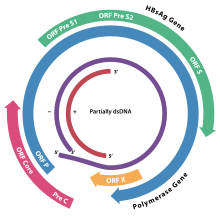HBsAg
| Large envelope protein | |||||||
|---|---|---|---|---|---|---|---|
| Identifiers | |||||||
| Organism | |||||||
| Symbol | S | ||||||
UniProt | Q9QAB7 | ||||||
| |||||||

HBsAg (also known as the Australia antigen) is the surface antigen of the hepatitis B virus (HBV). Its presence in blood indicates existing hepatitis B infection.
Structure and function
This section is missing information about the structure of the actual protein (not just where it’s found, but the S/M/L splicing and stuff) and the actual function and how (i.e. to get into the cell and not just "being recognized as foreign"). (July 2022) |
The viral envelope of an enveloped virus has different surface proteins from the rest of the virus which act as antigens. These antigens are recognized by antibody proteins that bind specifically to one of these surface proteins.
Immunoassay
Today, these antigen-
It is present in the sera of patients with viral hepatitis B (with or without
In
Positive HBsAg tests can be due to recent vaccination against Hepatitis B virus but this positivity is unlikely to persist beyond 14 days post-vaccination.[2]
History
It is commonly referred to as the Australia Antigen. This is because it was first isolated by the American research physician and
It was discovered to be part of the virus that caused serum hepatitis by virologist Alfred Prince in 1968.Heptavax, a "first-generation" hepatitis B vaccine in the 1980s, was made from HBsAg extracted from the blood plasma of hepatitis patients. More modern vaccines are made from recombinant HBsAg grown in yeast.
